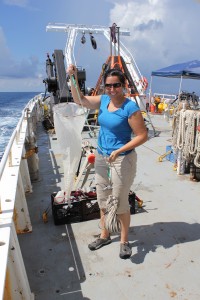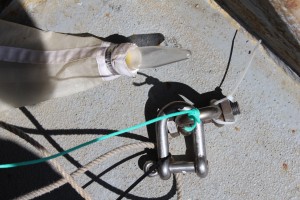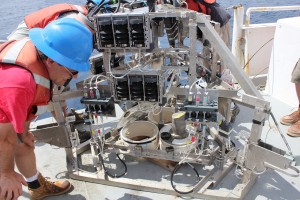Into New Depths…
Day 9 aboard the R/V Endeavor brought some new experiences.
 The first thing was an exploration of our own. Cris and I were curious about the types and amount of plankton living in these waters so we dropped a plankton net into the water and did a couple of tows. A plankton tow is where you drop a special net shaped like a cone (with a weight attached) down into the water and pull it up. The plankton net has a collection tube at the end (bottom) of it that traps little things from the water while the water escapes the net. Because it is such a fine net, very few things can escape, including most plankton.
The first thing was an exploration of our own. Cris and I were curious about the types and amount of plankton living in these waters so we dropped a plankton net into the water and did a couple of tows. A plankton tow is where you drop a special net shaped like a cone (with a weight attached) down into the water and pull it up. The plankton net has a collection tube at the end (bottom) of it that traps little things from the water while the water escapes the net. Because it is such a fine net, very few things can escape, including most plankton.
Second was the first deep water recovery for the Lander. The difference between shallow and deep water recovery is a result of how the Lander is put into the water. In previous deployments the Lander was attached via a line (rope) to a buoy. When we wanted to recover the Lander all we had to do was locate the buoy and pull the Lander up from the depths onto the Ship. With the deep water deploy al it’s done a little bit differently. The Lander is dropped into the water, and attached are 5 yellow containers which hold a glass ball inside of them. The purpose of the glass ball is to provide a pressure-resistant buoy that will make the Lander positively buoyant (float). The purpose of the yellow holder is to prevent the glass ball from breaking. The Lander has lead weights attached to it that weigh it down and pull the Lander and the buoys down the bottom of the sea once the line is let go from the Ship. Without those weights the yellow buoys would be enough to keep the Lander at the surface. The Landers weights are temporary and attached to a timer. Once the programmed time (about 18 hours) has passed, the Lander will be triggered to drop its weights. Without the weights to hold it down the Lander will float up, where will be waiting to collect it.
al it’s done a little bit differently. The Lander is dropped into the water, and attached are 5 yellow containers which hold a glass ball inside of them. The purpose of the glass ball is to provide a pressure-resistant buoy that will make the Lander positively buoyant (float). The purpose of the yellow holder is to prevent the glass ball from breaking. The Lander has lead weights attached to it that weigh it down and pull the Lander and the buoys down the bottom of the sea once the line is let go from the Ship. Without those weights the yellow buoys would be enough to keep the Lander at the surface. The Landers weights are temporary and attached to a timer. Once the programmed time (about 18 hours) has passed, the Lander will be triggered to drop its weights. Without the weights to hold it down the Lander will float up, where will be waiting to collect it.
 After collecting the Lander from Station 5, the scientists wanted to profile the water at various depths to get an idea of what its characteristics were like. They started out on a route that made a straight line south from station 5 and sampled the water every 10 miles or so. Up until now all of our samples have been taken from within a maximum of depth of 20 meters. Today our first stop brought waters that were 150 meters deep! I huge jump from where we’ve been. Our second stop proved even deeper with a depth of 550 meters and out third, 750 m! We are quickly seeing the depths grow now as we travel further south and still have one stop ahead of us.
After collecting the Lander from Station 5, the scientists wanted to profile the water at various depths to get an idea of what its characteristics were like. They started out on a route that made a straight line south from station 5 and sampled the water every 10 miles or so. Up until now all of our samples have been taken from within a maximum of depth of 20 meters. Today our first stop brought waters that were 150 meters deep! I huge jump from where we’ve been. Our second stop proved even deeper with a depth of 550 meters and out third, 750 m! We are quickly seeing the depths grow now as we travel further south and still have one stop ahead of us.
After dinner Nick gave Cris and I an overview of how the CTD works. Dr. Berelson had to have spent a great a mount of time not only building his Landers but thinking about building them. The details and inner workings are so intricate that it was clearly no simple task. Basically the Lander works through a series of levels that are held open by wiring; a computer is hooked up to all of the wires and once the timer says that its ready for an instrument to be used, an electric current will be sent through the wire which in turn burns it, resulting in the lever being let go and the sample collected. Once all samples have been collected the final wire to burn will drop its weights and the Lander will be light enough to return to the surface.
mount of time not only building his Landers but thinking about building them. The details and inner workings are so intricate that it was clearly no simple task. Basically the Lander works through a series of levels that are held open by wiring; a computer is hooked up to all of the wires and once the timer says that its ready for an instrument to be used, an electric current will be sent through the wire which in turn burns it, resulting in the lever being let go and the sample collected. Once all samples have been collected the final wire to burn will drop its weights and the Lander will be light enough to return to the surface.
We have one more CTD left to perform tonight and then we’ll be finished testing the water and off to our 6th station where tomorrow we will deploy a Lander, perform a Multi-core, run the In-situ pumps, perform a GO-Flo and collect water with the CTD. By now you are probably catching on to the rhythm of the collection methods and ordering and seeing a pattern develop. Although we are following a predictable pattern, each day out here brings some new and interesting activity, knowledge, or information.
Have a good night,
Wessal


 August 7, 2011
August 7, 2011 






Recent Comments